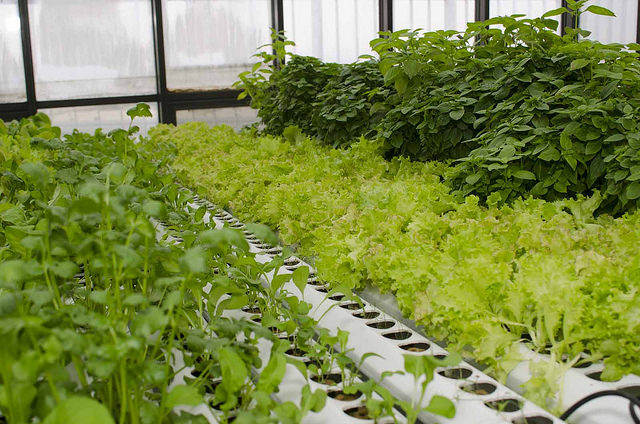What Is Nutrient Film Technique (NFT)?
This is Page 1 of our twelve page series on nutrient film technique. Click any of the below pages to jump to that page.
Page 1 Page 2 Page 3 Page 4 Page 5 Page 6 Page 7 Page 8 Page 9 Page 10 Page 11 Page 12

A mix of crop types and ages in an NFT system. Note the closeness of the NFT channels, and how large the plants are along the back of the photo.
One very popular method in hydroponics is called the Nutrient Film Technique, commonly abbreviated as NFT. In this approach, individual plants are initially rooted into a small pot with growing media, and the pot is then positioned into a shallow waterproof channel such as a rain gutter. Then nutrient solution is continuously circulated along the bottom of the channel, such that the roots are always in contact with the solution. As the plants grow, the roots grow out of the individual pots and into the channel. Once the roots are that long, they are continuously bathed in a shallow bath, or film, of nutrient solution (hence the name). While there are many variations in NFT setups, one of the critical issues is that the pots should hang above the bottom of the channel, rather than rest on the channel floor. This allows room not only for root development, but also for easier flow of the nutrient solution.
Nutrient film technique relies on the channels to be oriented on a slight slope, which allows the nutrient solution to move through the channels. Typically, a pump is used to lift the nutrient from a reservoir below the channels, into the tops of each channel. Then the sloping channels allow that nutrient solution to travel by gravity to the far end of the channel, nourishing the plants along the way. Usually, the channels will have a manifold at the end to gather the nutrient solution and return it to the reservoir.
The pot size, growing media and channel width are all dependent upon the plants being grown. One common pot option is called a net pot, which is a plastic pot molded into a net or open mesh shape. This allows very good gas and nutrient movement through the pot, while also allowing the roots easy access past the pot walls and into the channel. The mesh openings and overall pot dimensions will vary by brand, with a variety of sizes and options available. More conventional pots, which have solid walls and a few openings at the bottom, are not nearly as common since they force the roots out through the small bottom openings. Those openings are so small in fact that they can restrict root diameter, and/or finally become completely blocked by root development. Net pots are usually round rather than square in shape, and often have a lip or shelf molded into them which fits down into a lid covering the channel. This keeps foreign debris out of the channel. If purchasing a turnkey NFT system, the channel openings will be sized to match the pots provided with the system. If building a homemade system, make sure that he channel is wide enough for the intended pots, and the channel lid (if any) has openings which supports the pot without allowing it to fall through.
In This Series On Nutrient Film Technique......
We're going to look at a variety of details related to NFT production. That examination is organized under these headings:
- Advantages of NFT compared to other hydroponic systems
- Disadvantages of NFT compared to other hydroponic systems
- Growing Media
- Which Crops Work In NFT?
- Which Crops Don't Work In NFT?
- Estimated Cost
- Do It Yourself Potential
- Scalability
- Can Crops Be Germinated In This System?
- Can Crops Be Transplanted Into This System?
- Helpful Hints
- More Information
We have a lot of material to cover, so let's get started! Click on the Next link below for the first section, Advantages of NFT.
Next
Click any of the below links to jump to that page.
Page 1 Page 2 Page 3 Page 4 Page 5 Page 6 Page 7 Page 8 Page 9 Page 10 Page 11 Page 12